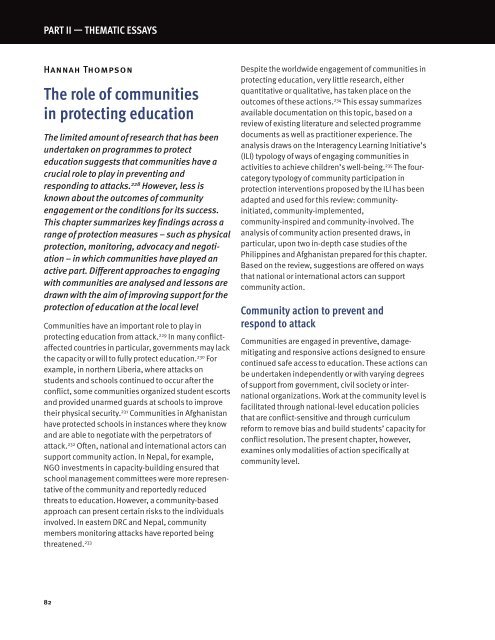eua_2014_full.pdf?utm_content=buffer4a392&utm_medium=social&utm_source=twitter
eua_2014_full.pdf?utm_content=buffer4a392&utm_medium=social&utm_source=twitter
eua_2014_full.pdf?utm_content=buffer4a392&utm_medium=social&utm_source=twitter
- No tags were found...
Create successful ePaper yourself
Turn your PDF publications into a flip-book with our unique Google optimized e-Paper software.
PART II — THeMATIC eSSAYSHannah ThompsonThe role of communitiesin protecting educationThe limited amount of research that has beenundertaken on programmes to protecteducation suggests that communities have acrucial role to play in preventing andresponding to attacks. 228 However, less isknown about the outcomes of communityengagement or the conditions for its success.This chapter summarizes key findings across arange of protection measures – such as physicalprotection, monitoring, advocacy and negotiation– in which communities have played anactive part. Different approaches to engagingwith communities are analysed and lessons aredrawn with the aim of improving support for theprotection of education at the local levelCommunities have an important role to play inprotecting education from attack. 229 In many conflictaffectedcountries in particular, governments may lackthe capacity or will to <strong>full</strong>y protect education. 230 Forexample, in northern Liberia, where attacks onstudents and schools continued to occur after theconflict, some communities organized student escortsand provided unarmed guards at schools to improvetheir physical security. 231 Communities in Afghanistanhave protected schools in instances where they knowand are able to negotiate with the perpetrators ofattack. 232 Often, national and international actors cansupport community action. In Nepal, for example,NGO investments in capacity-building ensured thatschool management committees were more representativeof the community and reportedly reducedthreats to education.However, a community-basedapproach can present certain risks to the individualsinvolved. In eastern DRC and Nepal, communitymembers monitoring attacks have reported beingthreatened. 233Despite the worldwide engagement of communities inprotecting education, very little research, eitherquantitative or qualitative, has taken place on theoutcomes of these actions. 234 This essay summarizesavailable documentation on this topic, based on areview of existing literature and selected programmedocuments as well as practitioner experience. Theanalysis draws on the Interagency Learning Initiative’s(ILI) typology of ways of engaging communities inactivities to achieve children’s well-being. 235 The fourcategorytypology of community participation inprotection interventions proposed by the ILI has beenadapted and used for this review: communityinitiated,community-implemented,community-inspired and community-involved. Theanalysis of community action presented draws, inparticular, upon two in-depth case studies of thePhilippines and Afghanistan prepared for this chapter.Based on the review, suggestions are offered on waysthat national or international actors can supportcommunity action.Community action to prevent andrespond to attackCommunities are engaged in preventive, damagemitigatingand responsive actions designed to ensurecontinued safe access to education. These actions canbe undertaken independently or with varying degreesof support from government, civil society or inter -national organizations. Work at the community level isfacilitated through national-level education policiesthat are conflict-sensitive and through curriculumreform to remove bias and build students’ capacity forconflict resolution. The present chapter, however,examines only modalities of action specifically atcommunity level.82


